
Montrose Center Opens Texas’ first LGBTQ-Affirming Senior Living Facility
Five LGBTQ seniors discuss their new homes in the Law Harrington Center.
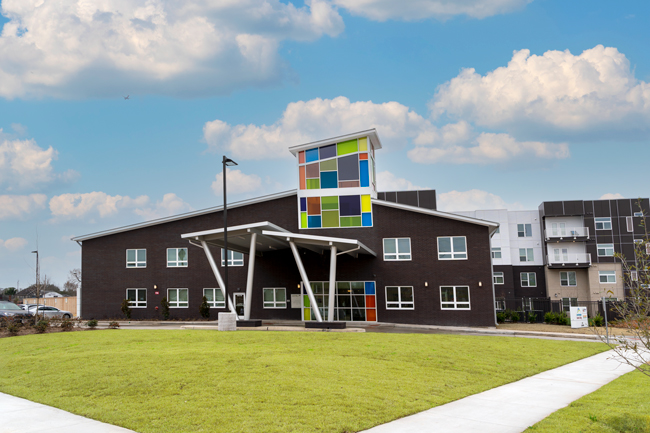
The first LGBTQ-affirming senior-living facility in Texas—and one of the largest of its kind in the country—is now open in Houston’s Third Ward.
The Montrose Center’s new Law Harrington Senior Living Center, located at 2222 Cleburne Street, was first announced by Space City’s LGBTQ resource center in 2018. Construction on the building is ongoing through March 11, and at press time, 18 seniors had moved into the center, while 60 of the building’s 112 units have been assigned.
“LGBTQ seniors are twice as likely to age in social isolation and four times less likely to have the money needed for retirement, in comparison to their heterosexual peers,” says Kennedy “Kent” Loftin, the Montrose Center’s chief development officer. On top of this, LGBTQ Houstonians lack city- and state-wide protections against housing discrimination.
The vast majority of LGBTQ-affirming businesses, churches, and service organizations remain in the Montrose “gayborhood” and surrounding areas, Loftin notes. But the lack of affordable housing in Montrose has pushed many LGBTQ low-income seniors into less community-centric areas.
To alleviate some of these problems, the Law Harrington Senior Living Center is open to all seniors ages 62 and over who meet low-income guidelines. The facility is just one mile from the Montrose Center on two existing Metro bus routes, and is also near a future light-rail line that is part of Houston’s Urban Corridor Plan.
Designed by Smith & Company Architects, the senior-living center features one- and two-bedroom independent-living apartments for both individuals and couples. The property also includes a social-services department managed by the Montrose Center, a geriatric primary-care clinic provided by Legacy Community Health, a group dining area, business center, library, fitness center, dog park, and outdoor recreational spaces.
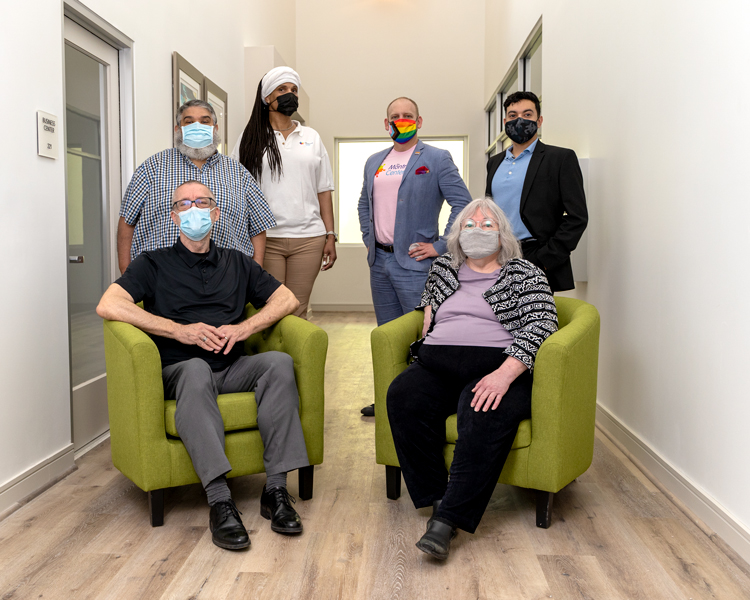
The Montrose Center has also launched a Taking Care of Our Seniors Fund to help seniors with their deposits, moving expenses and, in some cases, rental assistance.
Montrose Center Executive Director Ann Robison says that she and the late clinical director Chris Kerr started talking about a facility for LGBTQ seniors as early as 2010, and continued to revisit the subject often.
In January 2012, the Montrose Center screened the critically acclaimed documentary Gen Silent, which follows six LGBTQ seniors in their struggle to navigate the nation’s inadequate safety-net programs for seniors. The film surprised and troubled viewers. For Robison, the situation became personal when she learned about the situations that two of Houston’s LGBTQ senior activists, Jack Jackson and Rev. Ralph Lasher, had ended up in. Both were severely isolated in nursing facilities that had effectively forced them back into the closet.
At the Montrose Center’s Big Gay Block Party in September 2013, Robison talked with then-mayor Annise Parker about building an LGBTQ senior facility. They had only a few minutes to talk, but Parker was interested in the concept. During a trip to Los Angeles a few years later, Parker toured the Triangle Square senior-living complex and became convinced that Houston had the need and the resources to make a similar project happen.
The Montrose Center had previously launched their Seniors Preparing for Rainbow Years (SPRY) program in 2005, creating a vibrant community of older LGBTQ participants who receive life-enhancing services including professional counseling, case management, the Montrose Diner free congregate-meal program, community outreach, support groups, social activities, and wellness programs. In 2015, encouraged by Mayor Parker’s active interest in a senior-housing project following her Los Angeles tour, the Center resolved to expand SPRY services by building the Law Harrington Senior Living Center. The SPRY program will now operate out of the new facility.
The Law Harrington Senior Living Center was named in honor of Charles Law, a gay Black Houston activist who gave a stirring speech at the 1979 March on Washington for Lesbian and Gay Rights, and Gene Harrington, a gay white Houston HIV activist and professor at Texas Southern University.
On June 20, 2019, the Montrose Center finalized the necessary funding to start construction on the $26.5 million project in the Third Ward. After securing the necessary funding stream to start building—$23 million from grants, tax credits, and community donations—the Center broke ground on the facility on August 6 of that year.
The Center also raised funds through community donations, including the “There’s No Place Like Home” campaign, co-chaired by former Mayor Parker and State Representative Garnet Coleman (D-Houston).
Now that the facility is open, the Montrose Center is taking rental applications from singles and couples ages 62 and older whose annual income is below an amount calculated using current median-income data from the Houston area.
Those who think they meet the eligibility criteria and wish to receive further information can send an email to info@montrosecenter.org. For more information on the Montrose Center, visit montrosecenter.org.
Meet five seniors living in the Law Harrington Center.
DEBORAH BELL, 71
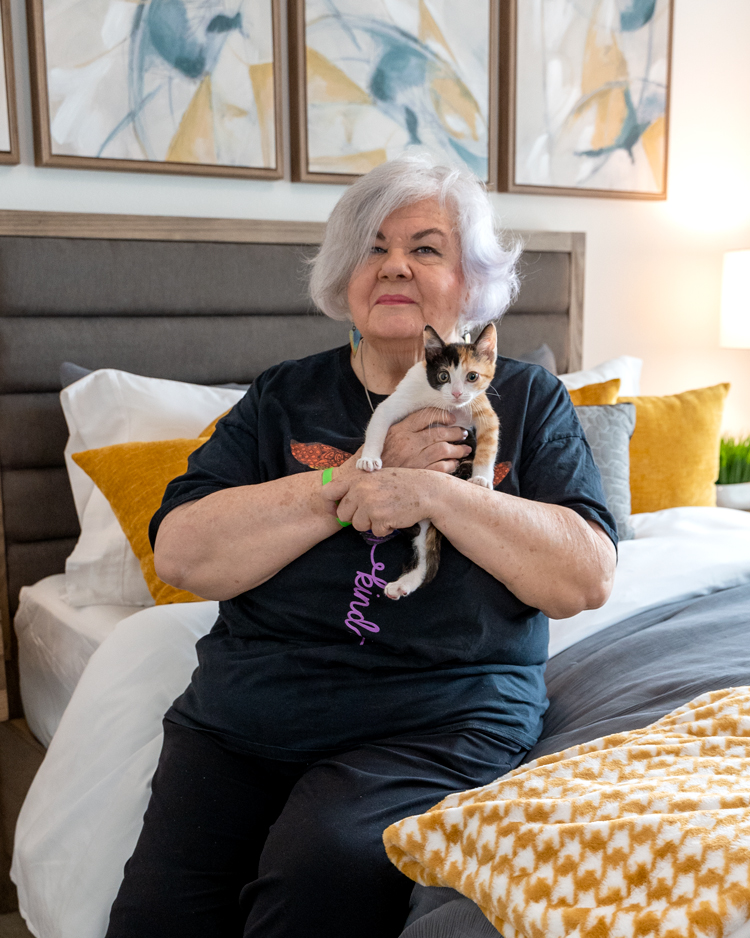 Deborah Bell moved into her new apartment on January 15. The seasoned lesbian activist had been renting living space with friends, so she was excited that the Montrose Center’s senior-living facility would enable her to finally have her own apartment and be a part of her own community. “This means everything for someone in a reduced financial situation,” she says.
Deborah Bell moved into her new apartment on January 15. The seasoned lesbian activist had been renting living space with friends, so she was excited that the Montrose Center’s senior-living facility would enable her to finally have her own apartment and be a part of her own community. “This means everything for someone in a reduced financial situation,” she says.
A native of Birmingham, Alabama, Bell first moved to Houston in 1966 when her father came here to work on the construction of the Astrodome. She became a busy activist in the community, and was elected Female Pride Marshal in 1997. She has worked for various local queer publications as an editor and writer, and has also been a mainstay in the Houston Women’s Group at First Unitarian Church. In addition, she has been involved in countless political campaigns as a Houston GLBT Political Caucus member.
Bell says that the new apartment facility is important because a lot of LGBTQ seniors don’t have family—often because close relatives are estranged or do not live in Houston.
Bell feels very safe in the facility, and is enjoying spending time with her new adopted calico kitten, Caledonia, and watching her apartment decorating ideas come together. She has retrieved several boxes that had been in storage, and is now rediscovering many “forgotten treasures” that she has collected over the years.
DON LAMIRAND, 72

Don Lamirand, a gay man, has been living at the Law Harrington Center since January 20. He moved from an apartment complex in the Meyerland area.
Lamirand loves his new apartment’s amenities and reasonable rent. “It is a bigger place with a dishwasher, washer and dryer, and a kitchen island. This apartment is brand new, and it’s like an ivory castle,” he says, adding that he loves to bake cakes and has already used his new kitchen to bake several.
A native of Cleveland, Ohio, Lamirand moved to Houston in 1957 when his father began working in the construction industry, which was booming at the time.
Lamirand had served on the focus group that the Montrose Center formed to offer suggestions for the design of the new complex. “I feel like I helped to design it,” he notes. He has been an active member of the Montrose Center’s SPRY program over the years, having lunch with other SPRY members at the Montrose Diner and taking part in organized field trips. He has also worked as a volunteer monitor in the Center’s computer room.
Over the past eight years, Lamirand has consistently marched in the Houston Pride parades with a variety of organizations, and can easily be identified by his rainbow suspenders and other wardrobe accessories.
Lamirand believes the new facility is important because it is open and welcoming to LGBTQ people, and it will help seniors avoid becoming socially isolated.
NIKKI NICOLE SPARKS, 69

Nikki Nicole Sparks, a trans woman, moved into her new home on January 15, and has only good things to say about the Law Harrington Center. “I love it here. The architects went all out for our community. The apartment floor plans are all so different, and there is a wonderful view of downtown. I love to sit in the lobby and meditate. I’m very thankful and grateful.”
Before moving in, Sparks had been the victim of domestic violence, and was eager to change her living situation. She will soon be joined by her beagle, Daisy Dukes, who is currently living with a friend.
A native of Galveston, Sparks moved to Houston in the mid-1970s because there were more job opportunities here. She has been active in the Montrose Center’s SPRY program, including the Montrose Diner. She attended the groundbreaking for the facility, and was so impressed with the architect’s renderings that she immediately got on the waiting list.
Sparks feels the facility is important because LGBTQ seniors want to live where they feel safe and comfortable. “I have such a sense of serenity here, and as soon as I come through the front door, I know that I won’t be judged, criticized, or humiliated for who I am.”
DINA JACOBS, 74
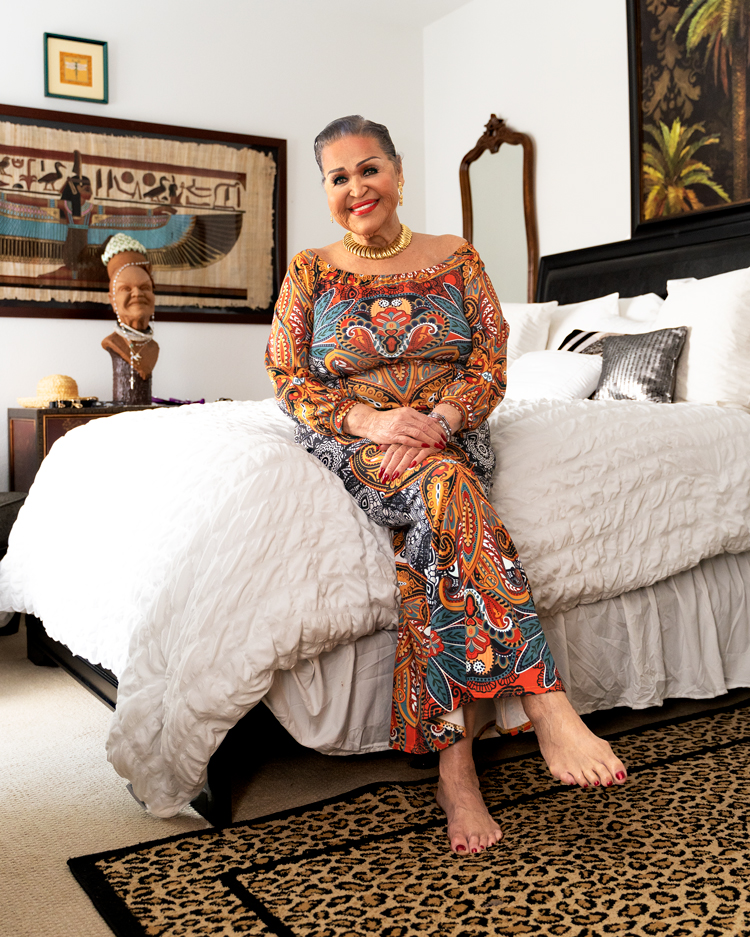
Dina Jacobs was the second resident to move into the new facility on January 11. She was living in another seniors apartment complex when she decided it was time for a change. “This place is incredible! I like just being here. Everything is brand new, and the people in the office are so nice,” she says.
Jacobs, a trans woman, has been a drag entertainer for 57 years and is still going strong. “Talent has no expiration date,” she emphasizes. Last May, a book about her life, Forever Her Mother’s Son: The Dina Jacobs Story—A Walk through the Life of a Transgender Drag Performer was published.
Born in Honolulu, Hawaii, Jacobs eventually moved to the mainland and settled in Atlanta. In the 1980s, she commuted to Houston to entertain at The Copa nightclub on weekends.
In 2011, Jacobs came to Houston to appear in a Legendary Ladies show, and decided to move here. She currently performs at Michael’s Outpost and Scott Gertner’s Rhythm Room.
Jacobs has performed to raise funds for benefits for as long as she can remember—events that have supported Sgt. Leonard Matlovich, AID Atlanta, the Life Foundation, Mint Julep, and the Texas Gay Rodeo Association, to name just a few.
Jacobs feels the Law Harrington facility is important because it is one of the few senior-living projects that cares about the LGBTQ community. “We deserve someplace comfortable to live after we are 65,” she says.
JEROME SCOTT, 68
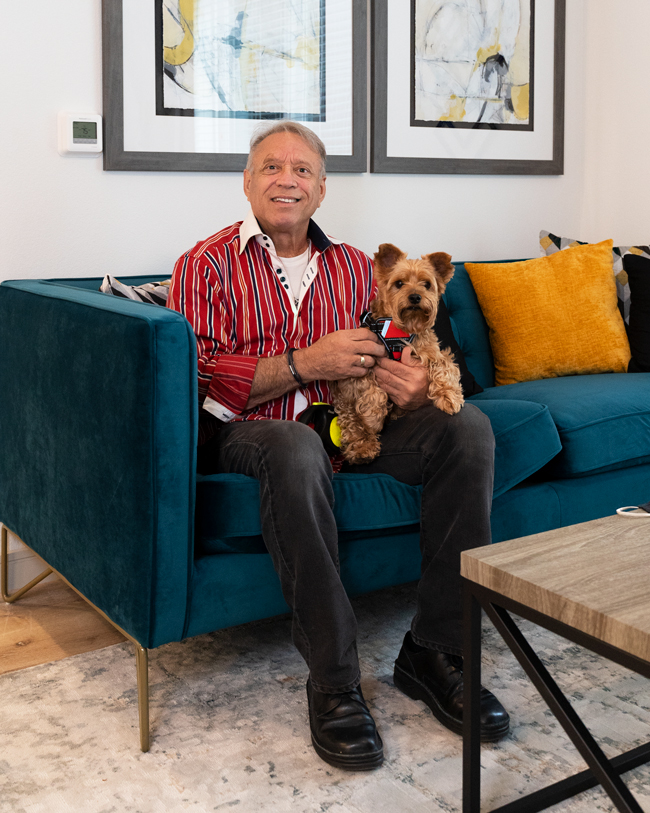
Jerome Scott, a gay man, will complete his move to the Law Harrington complex after he sells his house in southwest Houston. “I needed to downsize my life, and this seemed to be the right thing to do. It was the right time and the right place,” he says.
Scott, who is a long-term HIV survivor, is president of the Montrose Center’s HIV & Aging Coalition, a support group for seniors living with HIV. He feels the new facility is a perfect place for that organization’s meetings. “There is still a stigma about HIV,” Scott says. In addition to his years of leading HIV prevention training through various organizations, he has served on the Houston HIV Prevention Community Planning Group and as the president of AVES, an organization for Hispanics living with HIV.
A native of Seattle, Washington, Scott moved here in 1988 to begin a ten-year relationship with a man from Houston.
Scott says he believes the facility will be very beneficial for the LGBTQ, HIV, and senior communities, and he notes that “the approach they are taking is very open.” He hopes to sit on a resident committee after all the move-ins have been completed.
Scott feels the facility is important because it is so well suited for presentations and social events that will interest the many HIV-positive individuals who are entering their senior years. He plans to continue doing all he can to eradicate the stigma of HIV.










